Blair Mountain & Beyond
The Blizzard Clan
For more than a century the Blizzard family has been integral to the struggle for miners’ rights. Early in the 20th century, Timothy (Ma Blizzard’s husband) fought for the Union in the New River Coalfields. Prudence may well be the reason they settled in Eskdale on Cabin Creek. Ma Blizzard was frequently joined by Mother Jones on Paint and Cabin Creeks. The women fed by day and fought by night during the 1911-13 battles.
Even as a youngster, Ma’s son Bill, born in 1892, often went to the woods to “shoot something” to feed striking miners camped in their yard. Within a few short years Bill Blizzard emerged to lead thousands of miners in a 50-mile march and the ensuing 1921 Battle of Blair Mountain, the largest armed conflict in the United States since the Civil War. The battle was sparked by the murder of Sid Hatfield, the pro-Union Matewan Chief of Police. But the real cause of the conflict was the oppressive socio-economic system imposed on the miners by the coal operators.
Following the Battle, several hundred Union miners were shipped to Charles Town and tried on a variety of charges designed to result in mass hangings. A mere five years after the Russian Revolution, American capitalists were in no mood to tolerate an uppity labor movement. Thanks to brilliant tactics of our hero, Bill Blizzard, such as playing baseball with the friends and families of the jurors and faithfully attending church (Hallelujah!), there would be no hangings. Tested and trusted Union leaders emerged who would go on to organize West Virginia mines for the UMWA a decade later as FDR and the New Deal made organizing relatively safe.
Miners kept a code of silence that shaded events on Blair Mountain and the Trials for decades. The victory of Blair Mountain is best understood today as having three outcomes:
– Our Union was winning on the battlefield
– Won in the courtroom, and
– Emerged with a leadership cadre that successfully organized West Virginia in the early ‘30s and continued to lead the miners of West Virginia beyond mid-century.
Bill Blizzard retired as president of UMWA District 17 in 1955 after a career of unflinching loyalty to our Union and legendary and oft-controversial leader John L. Lewis.
Bill’s son, William C. Blizzard wrote When Miners March in the early 1950s. It is the definitive account of the West Virginia mine wars of the early 20th Century–who shot whom, when, where and why. Too controversial to publish in the ‘50s, his book finally saw the light of day in 2004 after Wess Harris rescued it from a cluttered closet in WCB’s ancient single-wide. At age 87, William C. enjoyed a belated notoriety and was featured on the History Channel. He delighted in meeting with students and having them join him on picket lines. William C. Blizzard died in December of 2009, but his book and the Blizzard legacy live on.

This photo from 2009 in Charles Town at the celebration of the court house restoration is an artifact as is the subject, William C. Blizzard. WCB was a featured guest and here is beaming at kind words from Warren McGraw speaking to the crowd. WCB is holding the first edition of WHEN MINERS MARCH, his definitive history of our Union’s early struggles in West Virginia.
WCB was a tireless researcher and brilliant intellect. At the age of 90 he could still translate Latin and delighted in his ability to use words to paint pictures. He was in the courtroom 100 years ago when his father Bill was acquitted.
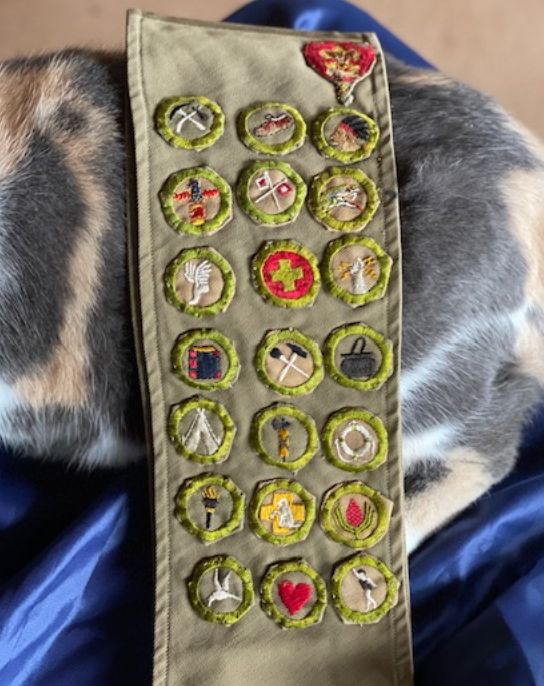
William C. Blizzard’s Eagle Scout Sash, which disputes the notion that his father, Bill Blizzard, was an ardent socialist….a “fact” from the historians at the West Virginia State Museum. No self-respecting socialist would allow his son to be an Eagle Scout!
Constable Model Gun

Each week the OUR STORY TRAVELING MUSEUM posts artifacts designed to Increase understanding of miners—especially Union miners—in West Virginia. Hopefully we can stimulate discussion and maybe even learn a bit. Anyone know the rest of the story on this 38 cal. “Constable model” made in Guernica, Spain and sold by Interarms from Alexandria, Va.?
The Traveling Museum got it from William C.Blizzard—-happily sans any casualties! At the age of 91 he kept it by his bed (very loaded) not so much in fear of robbers but as protection from the FBI and company thugs perceived to be a threat. His father, Bill Blizzard always kept a gun in each room of the house so perhaps WCB came by his caution honestly.
Bill the Younger said he got it in the mid/late ‘70s from Paul Nyden of Charleston Gazette fame when they were in Beckley teaching at Antioch. They frequented what he termed “rough” bars and his political activity on behalf of the McGraw brothers created some friction that mandated protection…
After WCB’s death I asked Paul about the gun and their adventures in Beckley but the rest of the story was not to be had. All I could get was a wry smile and eyes that recalled but would not talk! That was one (of several?) stories that Paul did not write about.
There are still some places in West Virginia where PPE does not only refer to a mask and gloves!
Ma Blizzard

Last week the artifact of the week was Ma Blizzard’s place (restaurant, beer joint, ice cream parlor) at Eskdale on Cabin Creek—as well as a $5 scrip piece from Eskdale. Several hundred folks responded with likes and comments. Thanks!
This week the OUR STORY TRAVELING MUSEUM has a color photo of Ma as our featured artifact. Taken in 1948 by her grandson William C. Blizzard and preserved only as a 35mm slide until restored early in this century, it is almost certainly the only existing color portrait of Ma Blizzard.
William C. did not know the slide he had gifted to me had been restored and he graciously signed it! Ma raised many children in need of a parent but she also could be a force to be reckoned with when the Bull Moose Special got too close. She also opened her home to another mother, Mother Jones, on more than one occasion.
Ma Blizzard's Place
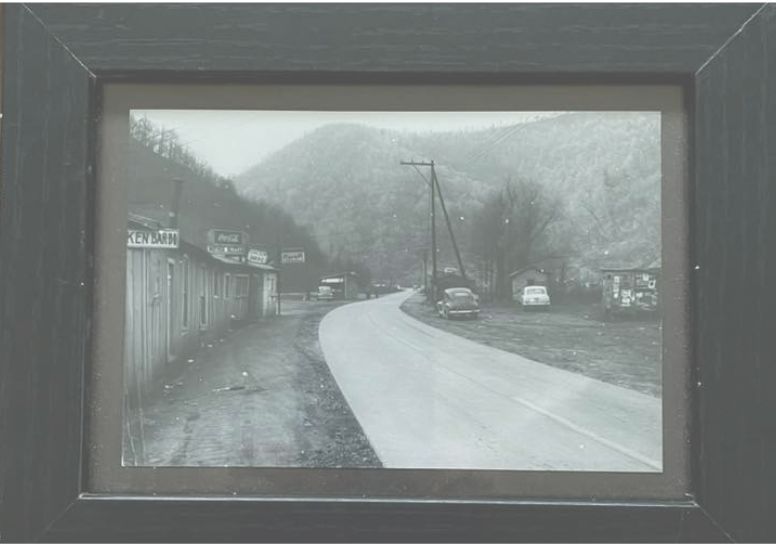
The long narrow building was Ma Blizzard’s place, reportedly either a place to get ice cream for the kids or beer for adults; depended on which door you entered. Hot dogs were 2 for a nickel and don’t even try to buy just one!
Union miners used it as a gathering place/watering hole and it could get a bit rowdy. I met a woman who recalled hiding behind the bar “many a time”.
The building was sandwiched between the road and the railroad. Ma and Timothy lived just across the tracks. Union miners pitched tents in their yard when on strike and Mother Jones stayed with them when in West Virginia. As a boy Bill was on occasion told to “go shoot something, the men are hungry.”
Eskdale was a town of heroes and Cleve Woodrum’s grave is there to prove it. Cleve was killed when seeking to avenge Cesco’s murder.

This piece of scrip post dates the worst of times and almost certainly Ma would take scrip (at a discount of course!)
Cleve Woodrum

Several inquiries this week about Cleve Woodrum. Folks have been getting emails from him so I had to check my facts. No doubt about it, Cleve is planted in Eskdale just across from Ma and Timothy’s place. Or at least the Union (District 17 under the presidency of Bill Blizzard—early ‘50s) put a marker up for him. My understanding is that Cleve was killed some months after Cesco. He was in on an ambush of Baldwin-Felts thugs to avenge Cesco but became a casualty.
Apparently Cleve is following in the footsteps of another Union hero, Joe Hill. He did not die.
Dead or alive, Cleve Woodrum is deserving of the honor of being this week’s artifact of the week for the OUR STORY TRAVELING MUSEUM. Hope he keeps sending those emails.
QUESTION OF THE WEEK: Time and place match. Anyone know if Bill Blizzard was in on the ambush???
Bill Blizzard

Last week Ma Blizzard made a big splash as artifact of the week from the OUR STORY TRAVELING MUSEUM. Check out this week’s artifact: None other than Ma’s son, Bill! This photo is from 1948 and was taken by William C. Blizzard, Bill’s son and author of WHEN MINERS MARCH. What a Union family!!!
Note that WCB signed this first print made from his original 3 mm slide.
Bill’s heroics on Blair Mountain are perhaps only surpassed by his brilliant tactics in Charles Town at the trial 100 years ago, in 1922. Sometimes you fight with guns. Sometimes a baseball, a bible salesman, and a few courtroom antics are the weapons to win the day! Win they did. Bill was president of District 17 when this was taken and arguably the most powerful man in West Virginia. While some would desert the UMWA, Bill remained loyal— never forgetting that John L. picked up the legal tab despite opposing the March.
Matewan -- Not a Massacre

There was no Matewan Massacre, but not because the coal companies did not want one! This is the legendary “one pounder” (actually two pounder) used by company operatives—not the government—against Union miners. A breech loading mountain rifle made in France, this gun was obsolete after WWI and became the coal operators’ approach to labor negotiations.
Now on loan to the OUR STORY TRAVELING MUSEUM, this weapon fired at Bill Blizzard (MISSED). Bill and his lifelong friend Charlie “Tuck” Payne captured it in the early 1950s. Not retired, this is still very much combat ready. We use it to blow holes in all the lies about how much coal companies love miners!
Earl T. Halloran

Earl T. Halloran was among West Virginia’s first pilots (perhaps the first). This week the OUR STORY TRAVELING MUSEUM offers a pic of the plaque in his honor at the WV Aviation Hall of Fame and this rare bio as our Artifact of the Week.
Earl was the leader of a squadron of 5 planes used by Island Creek Coal at Blair Mountain. He would ultimately be a Union hero—unsung for sure!—and save many lives. Under Halloran’s leadership, bombs were dropped with the intent of scaring fighters on both sides but not creating casualties. Disperse but not destroy.
Of course, miners had no way of knowing the benign intent and opened fire upon the mechanical birds. Upon returning to base, Earl discovered holes in his aircraft and prudently added steel plates under the seat and on his floor.

Model of plane flown by Earl T. Halloran over Blair Mountain in 1921
Union Miners Play Hardball

This week the OUR STORY TRAVELING MUSEUM is bringing out some very special artifacts as we mark 100 years after the infamous treason trials in Charles Town.
The ball is the most important ball in our nation’s history—responsible in no small part for saving not just a couple of hundred miner’s lives but arguably the entire American Labor Movement! Read about it in W.C. Blizzard’s WHEN MINERS MARCH as well as the more recent WRITTEN IN BLOOD.
The original roster lists player, position, charges against, and amount of bail. Note that the treason was treason against the state of WV, not the United States. The roster was written by Frank Snyder, designated team manager as he was considered too old to play. Frank gave the ball and roster to Gene Carter who passed it to Bill the Elder. Next to WCB (Bill the Younger) who gave them to yours truly with instructions to tell the story and sell his book!
The state museum displays a “soft ball” and offers up a pile of malarkey that the miners played for pleasure while on trial for their very lives. Nothing could be further from the truth! As William C. Blizzard explained in the Gazette back on June 16, 1963, the miners played to make friends with the locals-friends and family of the jury! Bill Blizzard made sure the boys did not win too many games and proceeds from the games went to local hospital needs. Never forget Union miners play hard ball!!!
Wonder why the whole story is seldom told? Follow the money!


Treason Trials Medallion

What a treasure! This week the OUR STORY TRAVELING MUSEUM artifact of the week was (appropriately) found out in Charles Town by Danny Lutz. He knows more about the infamous treason trials than any living human. This very ordinary medallion was resting in a box of Bill Blizzard’s personal treasures and Danny knew instantly …. I have had it in the museum for over a decade and was blind. Anyone know what you are seeing? Anyone ever see one? If you have one we must swap stories!!
Gold Watch for a Hero

This week the artifact of the week is this watch seen on page 214 of WHEN MINERS MARCH. It was given to Bill Blizzard by the miners who fought on Blair Mountain. Couple of weeks back I spoke to more than a few who participated in events staged around the centennial of the big battle. As I listened to accounts of the festivities (other than the appearance of the OUR STORY TRAVELING MUSEUM at Tamarack) it was clear that many got the impression that Fred Mooney, Frank Keeney, and dear Mother Jones were leaders of the March. Alas, for a variety of reasons all opposed the March and were absent. None got a gold watch for heroism. Blizzard did. He would lead the Union miners of West Virginia until he retired as President of powerful District 17 in 1955.

Rifle Stripper Clips

The OUR STORY TRAVELING MUSEUM is pleased to share this collection of artifacts from the battlefield on Blair Mountain. Thanks to Kenny King and Brandon Nida for years ago providing this week’s artifact. If anyone knows more about the battle, I have never met them!
Many stories here. The empty stripper clips top left speak to the reality of battle. Likely from an 03 Springfield, a weapon of choice during the battle. Military surplus, they could be had for $1.98 at Lowenstein’s Hardware. Sign is still there but now Ellen’s Ice Cream on Capitol Street. The 03A had a rear sight mounted behind the bolt, was perfected in the late 30s, and was much more accurate at range but not available on Blair Mountain. An important distinction missed by some…
The small wing nuts top center were likely from a field radio. Top right is testimony to the importance of music and the difficulty of taking a fiddle or banjo off to war! Center right is an exploded shell—perhaps the result of a forest fire long after the battle.
Shells embedded in the wood appear to be of a large caliber. Perhaps a hand gun or early machine gun? Shells in the stripper clip appear unmatched. Would the 03 handle such a mix? Of some note, the clips were dangerous when in battle. More than a few thumbs received serious lacerations in the heat of combat. Load quickly but carefully lest you slice a thumb when reloading! Old junk from a battle or truth telling windows to our story?
Arms for Armed Conflict

This week the OUR STORY TRAVELING MUSEUM offers another glimpse into the history of armed conflict.
This rifle is an 03 Springfield identical to those used on Blair Mountain in 1921 by both Union forces and Don Chafin’s thugs. The story here is found just in front of the chamber. The sight is raised so readers can note its location. This was a U.S. military weapon and likely sold as surplus after WW1. A high powered rifle the location of the sight gave it a bias to shoot high at short range. Added to the emotional rush of combat this defect may have saved more than a few lives on both sides in 1921.
The military came up with an improved version, the 03A, in the late 1930s. The 03A was used in WW2 and as late as the Vietnam conflict to counter snipers.
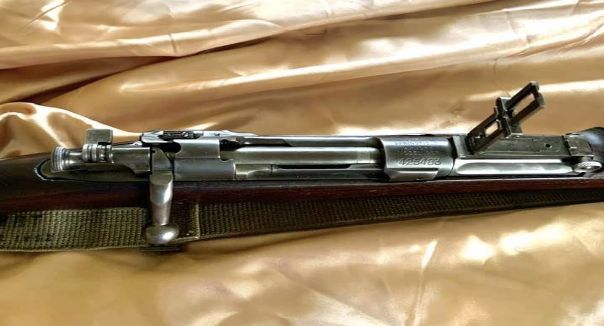

This model 95 Winchester is a thug gun from the McKell Coal Company in Glen Jean, West Virginia. A dozen of these rifles were given by William McKell to Kyle Allen as payment to Kyle for dumping two tripod-mounted machine guns in the New River near Thurmond. Kyle’s granddaughter gave this piece of history to the Traveling Museum. When we received it, there were still 2 shells hidden in the stock, wrapped in a cleaning rag. Note one is displayed elsewhere with Baldwin Felts badges.
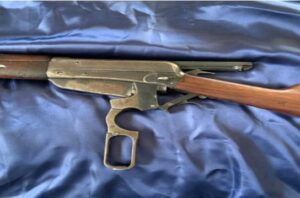

This week the OUR STORY TRAVELING MUSEUM offers this hog leg that has and teaches history. We have an air tight provenance. Got it from the same gal who provided the Model 95 Winchester featured earlier as a thug gun from the McKell Coal Company. “Grandpa” was McKell’s right hand man as well as enforcer at the pool hall. Imagine how proud I was to acquire such a piece of history!!!
Now comes the teaching part…..Got home and the house acquired a foul odor. Dang! Did not smell right. Long story short: Daddy, not Grandpa, passed this gun down. Likely bought it at a now defunct gun store in Marietta, Ohio in the mid ‘60s (19 not 18). This is arguably one of the most important artifacts in our Teaching museum.
Charter for Progressive Miners

Always learning! This week the OUR STORY TRAVELING MUSEUM offers as our artifact of the week (number 92 if we have counted correctly!) a charter from LU 304 of the Progressive Miners of America—-very different from the United Mine Workers of America! We have only a photo but know for certain that this charter was found at Bill Blizzard’s long-time home in Winfield. What is the story? How did Bill acquire it? Why did he keep it? Help us fill in the blanks! Hopefully we can add to this story. Thanks to the folks who shared this amazing document with us.

Always have mixed emotions about posting for “Labor Day”. The September holiday is cause to end summer, start football season, and celebrate working folks. Sadly, it also represents arguably the greatest strategic defeat ever suffered by the American Labor Movement. For more than a century the capitalist class has diversified and globalized (wonder where our jobs went and strikes no longer have the clout they once did?).
While the rest of the world celebrates Labor Day on May 1st., we agree to self-isolate our observance on a day in September. Divide and conquer ring a bell?
Having noted the complexity of Labor Day, the OUR STORY TRAVELING MUSEUM offers the two monuments pictured as our artifact of the week for this very conflicted celebration.
The gravestone labeled BLIZZARD is marking the grave not only of Bill Blizzard but also his wife Ray and both parents, Sarah (Ma) and Timothy. Our founder, William C Blizzard, author of WHEN MINERS MARCH, also rests there. No mention is made of this amazing family’s contribution to our Union.

The tiny monument pictured next to a pen (for scale) is the true monument of import this week. That is Bill’s name plate that rested on his desk when he served as President of famed—and feared—UMWA District 17.
Labor Day
Banner for L.U. 6102

The interest in scrip is growing with each artifact of the week post. This week the OUR STORY TRAVELING MUSEUM is pleased to share the Union banner from LU 6102 and a set of scrip from Marfrance. Their stories have a deep lesson—-beyond the purely voyeuristic pleasure of a glimpse into the past.
Sociology buffs in the crowd may recall that when humans interact two sources of power can be identified: people (think numbers) and money. The scrip clearly signifies the power of mine owners. They had the real money (capital) and were able to restrict miners to an occasional bit of tin that they minted. Pretend money. Scrip.
Seems some malcontents among the miners wanted to actually be paid for their efforts!! Few of them got together and Shazam! 6102 UMWA comes into being. People power wins over the power of capital. Which side are you on? Labor or capital??
Charter for L.U. 6652

This week the artifact of the week from the OUR STORY TRAVELING MUSEUM is the October 11, 1933 UMWA Charter for Local Union 6652 in Winona, Fayette County, West Virginia. This original charter was signed by Saint John L. Lewis during the height of organizing in the southern coal fields.
Bill Blizzard was likely involved with the formation of the Local due to his hero status following Blair Mountain. Any official credit could well have fallen to Van Bittner, an out-of-stater favored by Lewis. The relationship between Lewis, Bittner, and Blizzard was complex indeed…. No love lost but on the same Union team!

Enlargement of John L. Lewis’ signature
Marching Band UMWA Hat

These photos shed light on the power of our Union and how we adapted to a role of having power. We projected power with an in your face band that knew the meaning of swagger! Not to mention a large gathering of miners wearing suits…..

Anyone know more about this gang of rabble rousers? Same bunch from the trials back in ‘22?
John L. Hard Hat


An incredible week for the OUR STORY TRAVELING MUSEUM!!! A very special thanks to Elwood and Betty Maples for this John L hard hat—the style JLL wore when underground! Elwood saved much from the District 29 dumpster and now a large portion of his collection joins the Traveling Museum. Some documents have already made it to Radford University. Elwood was quite sure that John L walked on water. Good friend Julian Martin recalls answering JOHN L LEWIS when asked in school : Who is the president??

John L. Lewis Style Hard Hat
Labor Union Contract

Save the contents for later. This week’s artifact of the week is the size. Size matters! This contract ( and countless others) will fit a pocket or a dinner bucket. Never hurts to know the rules!! Recall the late great Saint Robert Byrd always carried an American Constitution in his pocket to keep in mind who he was and for whom he worked!
Help me out here— do readers of these posts still keep the practice? Bill Blizzard kept copies of all of the Union contracts he helped come into being. He (like many Union leaders of his day) kept a .32 cal pistol in a pocket as well. Not too big and heavy so as not to make britches sag!
Local 8945 Seal

It’s not official without the seal. UMWA Local 8945 may be history — anyone know their story?
Even so, keep an eye out in case of a rebirth!
Miners' Teapot Lamp

This rare teapot lamp dates from the late 19th/early 20th century. It is currently in the OUR STORY TRAVELING MUSEUM. This week marking 100 years since the gun fight in Matewan has been marked by numerous claims that the Labor Movement in West Virginia began with that fight. Perhaps ask the teapot when miners started organizing!
Jack Rocks Earrings

This week the OUR STORY TRAVELING is pleased to share a couple of photos of favorite toys from bygone days. Made by elves (never Union miners!) the Jack Rocks are said to improve miner safety on picket lines. Would not want any pedestrians injured by coal trucks….

The historic earrings were worn on the picket line by miner’s wives to thank the elves. More recently, modern day Union women have been seen wearing classy sterling silver versions!
The jackrock earrings were worn during the Pittston Strike by Marat Moore.
Banner for L.U. 6200

This week the artifact of the week is this colorful banner from LU 6200. The banner was on display back “home” in Greenbrier County last week. Friday the OUR STORY TRAVELING MUSEUM was in Lewisburg at New Chapter Books (a fun place) and Saturday we ventured to the Rupert Library —hottest spot in Rupert.
1898 Mourning Ribbon
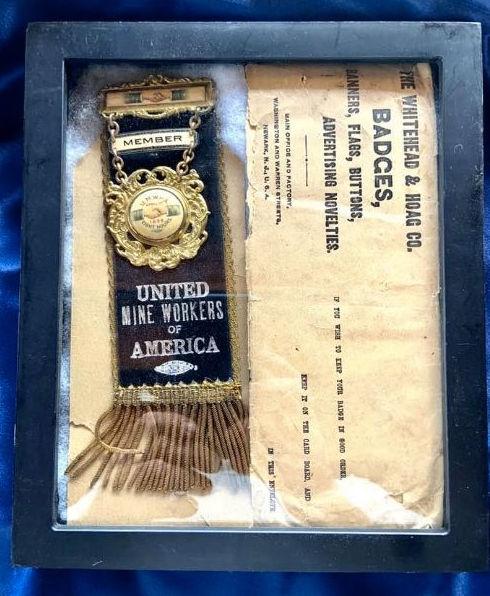
This 1898 ribbon is shown with the original paper wrap. Actually this is just half of the ribbon— the black mourning half. The other side would be identical but in flag colors of red, white, and blue. The “patriotic” half would be worn to Union events other than funerals and such. Upon a miners death the colorful side would be removed and buried with him. The side displayed here would remain with the family as a momento, perhaps saved as here with the original packaging.
Glad to share this artifact of the week from the OUR STORY TRAVELING MUSEUM. Watch in coming weeks for a very special ribbon from Sun, WV. We will be adding extremely rare artifacts as we commemorate the events on Blair Mountain — and after…..
